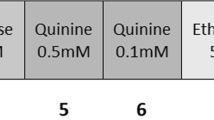Abstract
Recent studies have found the LEW/N rat self-administers drugs of abuse at higher rates than the F344/N rat, suggesting a genetic predisposition toward the abuse potential of drugs. The current study compared the acquisition of a conditioned taste aversion (CTA) to cocaine in these strains. During an initial 20-min daily session a 0.1% saccharin solution was available and a dose (0–50 mg/kg, SC) of cocaine was given immediately after that session. Water was available during sessions on the following 3 days. Fluid consumption was assessed over three saccharin/water cycles, and a final saccharin session. Vehicle injections (0 mg/kg) that followed exposure to saccharin had no effect on subsequent saccharin consumption. In contrast, when cocaine followed exposure to saccharin, rates of saccharin consumption decreased over successive saccharin sessions in a dose-related manner in both strains. The lowest dose (18 mg/kg) decreased consumption in LEW/N rats but not in F344/N rats. An intermediate dose (32 mg/kg) decreased consumption maximally in LEW/N rats and only marginally in F344/N rats. The highest dose (50 mg/kg) decreased consumption completely in LEW/N rats and almost completely in F344/N rats. These findings demonstrate that significant differences in sensitivity to stimuli paired with cocaine occur between these strains. These differences are consistent with previous reports that the LEW/N rat is uniquely sensitive to both behavioral and biochemical effects of drugs of abuse. The current report extends this sensitivity to the noxious effects of these drugs. To the extent that noxious and reinforcing effects of cocaine are unrelated, these results suggest that the LEW/N rat does not exhibit a genetic predisposition to factors related only to the abuse potential of drugs.
Similar content being viewed by others
References
Beitner-Johnson D, Guitart X, Nestler EJ (1991) Dopaminergic brain reward regions of Lewis and Fischer rats display different levels of tyrosine hydroxylase and other morphine and cocaine-regulated phosphoproteins. Brain Res 561:147–150
Conover WJ (1980) Practical nonparametric statistics. Wiley New York
Ferrari CM, O'Connor DA, Riley AL (1991) Cocaine-induced taste aversions: effect of route of administration. Pharmacol Biochem Behav 38:267–271
Garcia J, Kimeldorf RA, Koelling RA (1955) Conditioned aversion to saccharin resulting from exposure to gamma radiation. Science 122:157–158
George FR, Goldberg SR (1988) Genetic differences in responses to cocaine. Mechanisms of cocaine abuse and toxicity. NIDA Research Monograph Series #88, US Dept HHS, Rockville, MD, pp 239–249
George FR, Goldberg SR (1989) Genetic approaches to the analysis of addiction process. TIPS 10:78–83
Glowa JR, Geyer MA, Gold PW, Sternberg EM (1992a) Differential startle amplitude and corticosterone response in rats. Neuroendocrinology 56:719–723
Glowa JR, Sternberg EM, Gold PW (1992b) Differential behavioral response in LEW/N and F344/N rats: effects of corticotropin releasing hormone. Prog Neuropsychopharmacol Biol Psychiatry 16:549–560
Guitart X, Beitner-Johnson D, Marby DW, Kosten TA, Nestler EJ (1992) Fischer and Lewis rats strains differ in basal levels of neurofilament proteins and their regulation by chronic morphine in the mesolimbic dopamine system. Synapse 12:242–253
Katzev RD, Mills SK (1974) Strain differences in avoidance conditioning as a function of the classical CS-US contingency. J Comp Physiol Psychol 87:661–671
Koob GF, Bloom FE (1988) Cellular and molecular mechanisms of drug dependence. Science 242:715–723
Nestler EJ (1992) Molecular mechanisms of drug addiction. J Neurosci 12:2439–2450
Piazza PV, Deminiere JM, LeMoal M, Simon H (1989) Factors that predict individual vulnerability to amphetamine self-administration. Science 245:1511–1513
Piazza PV, Maccai S, Deminiere JM, LeMoal M, Mormede P, Simon H (1991) Corticosterone levels determine individual vulnerability to amphetamine self-administration. Proc Natl Acad Sci 88:2088–2092
Pickens RW, Svikis DS (1988) Biological vulnerability to drug abuse. NIDA Research Monograph Series #89, US Dept HHS, Rockville, MD
Riley AL, Tuck DL (1985) Conditioned taste aversions: a behavioral index of toxicity. In: Braveman N, Bronstein P. (eds) Experimental assessments and clinical applications of conditioned food aversions. Ann NY Acad Sci 443:272–292
Sternberg EM, Glowa JR, Smith MA, Calogero AE, Listwak SJ, Aksentijevick S, Chrousos GP, Wilder RL, Gold PW (1992) Corticotropin releasing hormone related behavioral and neuroendocrine responses to stress in Lewis and Fischer rats. Brain Res 570:54–60
Suzuki T, George FR, Meisch RA (1988) Differential establishment and maintenance of oral ethanol reinforced behavior in Lewis and Fischer 344 inbred rat strains. J Pharmacol Exp Ther 245:164–170
Author information
Authors and Affiliations
Rights and permissions
About this article
Cite this article
Glowa, J.R., Shaw, A.E. & Riley, A.L. Cocaine-induced conditioned taste aversions: comparisons between effects in LEW/N and F344/N rat strains. Psychopharmacology 114, 229–232 (1994). https://doi.org/10.1007/BF02244841
Received:
Revised:
Issue Date:
DOI: https://doi.org/10.1007/BF02244841




